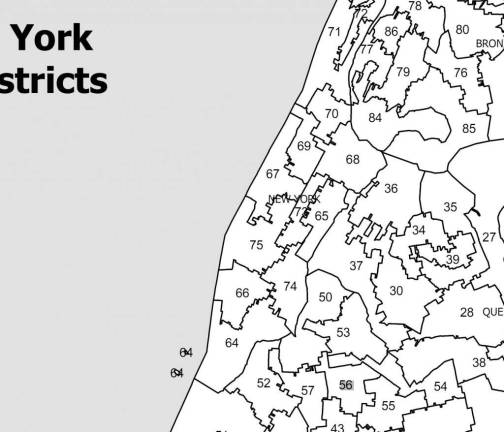Downtown Democrats Wary of Redistricting Process

Say current LATFOR map would weaken area's representation
To many city residents, redistricting, whereby states redraw their political maps every decade to reflect population shifts recorded in the most recent census, is an all- too-complex, seemingly esoteric process best left to political pundits and policy wonks.
New York, which has yet to approve redrawn legislative and congressional districts for this year's election, is among one of the last states to comply with the mandate.
But at a meeting last Wednesday, Feb. 22, of the Downtown Independent Democrats (DID) in Tribeca, the message on redistricting was loud and clear: Partisan redistricting will weaken the Downtown community's voice as it faces major issues.
In its resolution on redistricting, the DID expressed disappointment in the map released by the New York Legislative Task Force on Demographic Research and Reapportionment (LATFOR). "Both the Senate and Assembly maps have been gerrymandered to favor political parties and incumbent politicians with little or no concern for community representation. This is undemocratic and unwise," the resolution states.
At the meeting, Assembly Member Brian Kavanagh, who has been in office since 2007 and who stands to get more of Downtown as a result of the redistricting, noted that the LATFOR maps included significant changes.
"There is tremendous uncertainty here regarding the district lines and dates," Kavanagh said. He added that it now looks as if the lines will be redrawn.
However, time is now of the essence, as the congressional primary has been set for Jun. 26 and the legislative primary for Sept. 11.
In keeping with the recent court decision to appoint a special magistrate to help with redistricting, on Monday, Feb. 27, a panel of judges in federal court in Brooklyn seized control of the congressional part of the redistricting process. They ordered magistrate Roanne L. Mann to prepare a map and deliver a proposal for the judges' consideration by Mar. 12.
With the help of a redistricting expert, a professor at Columbia Law School, the judges say they will produce a revised congressional map by Mar. 20, the date set for the petitioning of prospective congressional candidates.
"The most important thing for me from the point of view of a local district leader is that we need to know what the lines are as soon as possible," said Republican District Leader Janet Hayes.
Hayes said she agreed with the call for community cohesion and cited one example where the opposite was done "in her backyard": the proposed 75th Assembly District had a bizarre "spike" running north from Midtown west to the Upper West Side, enabling the incumbent's residence to be included in the district.
"With district lines like these that are drawn to accommodate a single individual," Hayes said, "it's no wonder that the average citizen is cynical about the process."
Paul Newell, Democratic district leader in the 64th Assembly District, is also cynical about the redistricting process. "Albany insiders in both parties drew this map to essentially scratch each others' backs," Newell said in an email.
"The [Republican-drawn] Senate map is much, much worse. But Assembly Democrats are equally responsible for it, as they will have to pass those lines," Newell continued. "Why do they not stand up for their fellow Democrats in the Senate (and the millions of New Yorkers they represent)? Because they get the prize of drawing their own safe districts."
Newell added that his proposed rules to ensure a more equitable redistricting process would take into account population equity, community cohesion (keeping neighborhoods together as voting blocs), minority representation and geographic compactness.
DID President Jeanne Wilcke explained that it's important for residents to be informed about the controversy surrounding the changing of lines of elected officials.
Wilcke said that most residents are not aware that state elected officials are "playing" with the area's voting power by redrawing lines that split up downtown New York City neighborhoods.
"You want officials who represent all of a given neighborhood," she says. "Community input and pressure is what gets elected officials to do the right thing and represent the people's interests."
Underscoring the ill effects of inequitable district lines, Wilcke said, "It is harder to elect a good candidate when only half the community voting power can vote the candidate in, or vote out an official who has wronged your community when only half in the neighborhood can vote that person out."
Moreover, she said, Soho would not be what it is today without residents organizing to get laws changed to legalize artists' live/work lofts. "Many of our state elected officials promised to allow an independent commission to redraw fair district lines," Wilcke said. "That hasn't happened?If our elected officials cannot do the job, it is time for the judges to step in and force fair voting districts for the people."